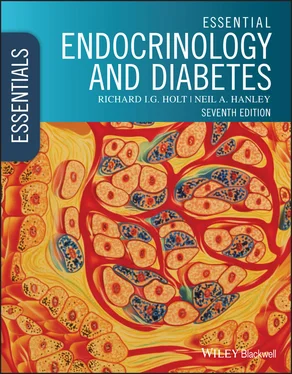†The list is far from exhaustive for the gastrointestinal tract (see Chapter 11).
Hormone responses can be widespread or incredibly focussed according to how widely the hormone’s receptor is distributed. For instance, thyroid hormone acts on many, if not all, of the more than 200 cell types in the body. The body’s entire metabolic rate increases if it is present in excess and declines if there is a deficiency ( Chapter 8). Similarly, insulin acts on most tissues; an importance underlined by its pivotal role in the survival and growth of many cell types in laboratory culture. In contrast, other hormones may act only on one tissue. For instance, thyroid‐stimulating hormone (TSH), adrenocorticotrophic hormone (ACTH) and the gonadotrophins are secreted by the anterior pituitary and regulate specific cell‐types in the thyroid gland, the adrenal cortex and the gonads, respectively ( Table 1.2).
Classification of hormones
There are three major groups of hormones, defined according to their biochemical synthesis ( Box 1.4). Peptide or protein hormones are synthesized like any other cellular protein. The amino acid derivatives and steroid hormones originate from a cascade of intracellular enzymatic reactions.
The majority of hormones are peptides and range in size from tiny, only three amino acids [thyrotrophin‐releasing hormone (TRH)], to small proteins of >200 amino acids, such as TSH or luteinizing hormone (LH). While some peptide hormones are secreted directly, a typical feature is their storage in granules, the release from which is commonly controlled by another hormone, as part of a cascade, or by innervation.
Some peptide hormones have complex tertiary structures or comprise more than one peptide chain encoded by multiple genes. Oxytocin and vasopressin, the two posterior pituitary hormones, have ring structures linked by disulphide bridges. Despite being remarkably similar in structure, they have markedly different physiological roles ( Figure 1.3). Insulin consists of α‐ and β‐chains linked by disulphide bonds. Like several hormones, it is synthesized as an inactive precursor that requires modification prior to release and activity. To some extent, this regulation protects the synthesizing cell from being overwhelmed by the action of its own hormone. The gonadotrophins, follicle‐stimulating hormone (FSH) and LH, TSH and human chorionic gonadotrophin (hCG) also have two chains. However, these α‐ and β‐subunits are synthesized separately from entirely different genes. The α‐subunit is common to each of the hormones. It is the distinctive β‐subunit of each that confers biological specificity.
Box 1.4Major hormone groups
Peptides and proteins
Amino acid derivatives
Steroids

Figure 1.3 The structures of vasopressin and oxytocin are remarkably similar, yet the physiological effects of the two hormones differ profoundly.
These hormones are small water‐soluble compounds. Melatonin is derived from tryptophan, whereas tyrosine derivatives include thyroid hormones, catecholamines, and dopamine, which regulates prolactin secretion in the anterior pituitary. The catecholamine hormones, epinephrine (also called adrenaline) and norepinephrine (noradrenaline) are secreted by the adrenal medulla as well as being sympathetic neurotransmitters, emphasizing the close relationship between the nervous and endocrine systems ( Figure 1.2). Like peptide hormones, they are stored in granules prior to release.
Steroid hormones are lipid‐soluble molecules derived from cholesterol. Cholesterol is present in all cells as a basic constituent of the cell membrane. However, in the steroid hormone synthesizing cells of the adrenal cortex, gonad and placenta, it is also extracted from the circulation and stored intracellularly as cholesterol esters. Steroid hormones are insoluble in water and circulate largely bound to plasma proteins.
Control systems regulating hormone production
The synthesis, release and circulating level of hormones are regulated by control systems, similar to those used in engineering. These mechanisms ensure that hormone signals can be limited in amplitude and duration. Central to the regulation of many different endocrine organs is the anterior pituitary gland, which, in turn, is controlled by several hormones and factors released from specialized hypothalamic neurones ( Chapter 5). Thus, the body’s major endocrine axes comprise the hypothalamus, anterior pituitary and an end organ, the adrenal cortex, thyroid, testis or ovary. An understanding of these control mechanisms is crucial for appreciating endocrine physiology and its clinical investigation.
An elementary control system is one in which the signal itself is limited, either in magnitude or duration, so as to trigger only a transient response. Certain neural impulses are of this type. Responsiveness of the target cell is set to discriminate between a positive signal, when a cell responds, and background ‘noise’, when a response is not triggered. An example is the pulsatile release of gonadotrophin‐releasing hormone (GnRH) from the hypothalamus.
Negative feedback is the commonest form of regulation used by biological systems. For example, in enzymology, the product frequently inhibits its own catalyzed reaction. In endocrinology, a hormone may act on its target cell to elicit a response (often secretion of another hormone) that then inhibits production of the original hormone ( Figure 1.4a). The same effect can come from a metabolic process. For instance, the pancreatic β‐cell makes insulin in response to high surrounding glucose levels. The effect is to lower glucose, which, in turn, inhibits further insulin production. The hypothalamic–anterior pituitary–end organ axes are a slightly more complex extension of this model. The hypothalamic hormone [e.g. corticotrophin‐releasing hormone (CRH)] stimulates release of the anterior pituitary hormone (e.g. ACTH), which, in turn, increases peripheral hormone production (e.g. cortisol). The peripheral hormone then feeds back via the circulation to inhibit further production of the anterior pituitary and hypothalamic hormones. Figure 1.4b illustrates the anterior pituitary and end‐organ components of this model where hormone 1 could be ACTH and hormone 2 could be cortisol.
Under certain more unusual circumstances, hormone feedback enhances, rather than inhibits, the initial response. This is called positive feedback (illustrated alongside the more usual negative feedback by the plus sign in Figure 1.4a). This is intrinsically unstable and always has built‐in self‐limiting features. Transiently, it can be beneficial. For instance, the action of oestrogen on the pituitary gland induces the ovulatory surge of LH and FSH, further stimulating oestrogen production in the developing follicle ( Chapter 7). During childbirth, stretch receptors and nerves from the distended vagina stimulate the posterior pituitary to release oxytocin. The rise in oxytocin causes more uterine contraction, further activating the stretch receptors. The role of oxytocin in the suckling–milk ejection reflex is similar. In each instance, the positive feedback amplifies a signal until there is a break in the circuit, either ovulation, birth of the baby or the cessation of suckling.
Читать дальше













